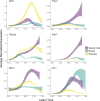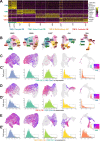scRNA-sequencing in chick suggests a probabilistic model for cell fate allocation at the neural plate border
- PMID: 37530410
- PMCID: PMC10425176
- DOI: 10.7554/eLife.82717
scRNA-sequencing in chick suggests a probabilistic model for cell fate allocation at the neural plate border
Abstract
The vertebrate 'neural plate border' is a transient territory located at the edge of the neural plate containing precursors for all ectodermal derivatives: the neural plate, neural crest, placodes and epidermis. Elegant functional experiments in a range of vertebrate models have provided an in-depth understanding of gene regulatory interactions within the ectoderm. However, these experiments conducted at tissue level raise seemingly contradictory models for fate allocation of individual cells. Here, we carry out single cell RNA sequencing of chick ectoderm from primitive streak to neurulation stage, to explore cell state diversity and heterogeneity. We characterise the dynamics of gene modules, allowing us to model the order of molecular events which take place as ectodermal fates segregate. Furthermore, we find that genes previously classified as neural plate border 'specifiers' typically exhibit dynamic expression patterns and are enriched in either neural, neural crest or placodal fates, revealing that the neural plate border should be seen as a heterogeneous ectodermal territory and not a discrete transitional transcriptional state. Analysis of neural, neural crest and placodal markers reveals that individual NPB cells co-express competing transcriptional programmes suggesting that their ultimate identify is not yet fixed. This population of 'border located undecided progenitors' (BLUPs) gradually diminishes as cell fate decisions take place. Considering our findings, we propose a probabilistic model for cell fate choice at the neural plate border. Our data suggest that the probability of a progenitor's daughters to contribute to a given ectodermal derivative is related to the balance of competing transcriptional programmes, which in turn are regulated by the spatiotemporal position of a progenitor.
Keywords: cell fate decisions; chicken; developmental biology; neural crest; neural plate; sensory placodes.
© 2023, Thiery et al.
Conflict of interest statement
AT, AB, EH, CC, NL, JB, AS No competing interests declared
Figures















Update of
- doi: 10.1101/2022.02.15.480567
References
Publication types
MeSH terms
Grants and funding
LinkOut - more resources
Full Text Sources

